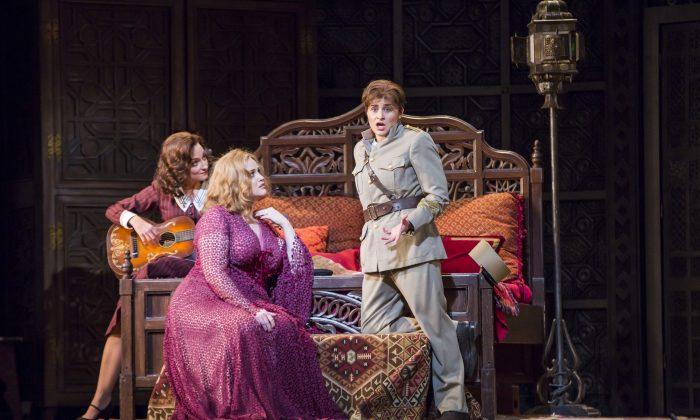NEW YORK—With Mozart’s music, Harry Bicket in the pit, and a top-flight cast, Mozart’s comic masterpiece, “Le nozze di Figaro” (“The Marriage of Figaro”) is in capable hands.
Pierre Beaumarchais wrote the play “The Barber of Seville” about Count Almaviva wooing and winning the hand of beautiful Rosina. The count, with the help of the wily barber Figaro, helped trick the young woman’s guardian, Doctor Bartolo.
The playwright wrote a sequel, taking place years later, when the count’s marriage is on the rocks because of his womanizing. Mozart and his librettist Lorenzo Da Ponte wrote the opera, “Le nozze di Figaro” based on the second play.
Thirty years after the debut of Mozart’s opera, Rossini presented his opera based on “The Barber of Seville.” Both are masterpieces, but the Mozart opera is the richer work, with much comedy and also depth of feeling.
The Met’s current production was directed by Sir Richard Eyre with set and costumes by Rob Howell. The pair also teamed up for “Carmen,” and the productions have several similarities and differences. Both are set in Seville, with the time period moved up to the 1930s.
This time change feels right for “Carmen” since the oppressive conditions during the Spanish Civil War fit the tragic mood of the piece.
But “Le nozze di Figaro” is far lighter in tone. The director has said that he was inspired by Jean Renoir’s classic film “The Rules of the Game.” But setting “The Marriage of Figaro” in the same time period doesn’t add anything to the opera. In fact, it creates some confusion since the first night rights of the aristocracy, which Figaro fears the count will exercise, were no longer in practice by the ’30s.
The Plot
In this production, the action begins during the overture. The revolving set shows the early morning activities at Almaviva castle. The count’s latest conquest rushes onstage to get dressed, while the countess is sleeping, and staff members are engaged in their morning tasks.Figaro, now working for the count, is set to marry the countess’s maid Susanna. But the count has designs on her as well.
The countess and Susanna foil the Count with the help of Cherubino, a teenage boy in love with all the women in the house, especially the countess. The women get Cherubino (a part for a mezzo–soprano) to pose as a woman, and Eyre comes up with some nice comic touches, such as the boy’s attempt to walk in high heels.
Also complicating matters is the appearance of Marcellina, who loaned money to Figaro and now wants him to marry her because he has failed to pay her back. She is assisted by Bartolo.
It ultimately turns out that Marcellina and Bartolo are Figaro’s mother and father. When the count shows up for what he believes to be an assignation with Susanna, he discovers a woman he believes to be his wife romancing Figaro.
The Production
Among the evening’s highlights are Adam Plachetka as Figaro in his “Non più andrai” (telling Cherubino all he will lose when the count orders the boy to join the army) and his diatribe against women, “Aprite un po’ quegli occhi.”Baritone Luca Pisaroni is convincing as the seductive count, and American soprano Rachel Willis-Sorensen is poignant as Countess Almaviva. She delivers lovely renditions of “Dove sono” and “Porgi, Amor.”
Christiane Karg is a feisty Susanna, and Serena Malfi is immensely appealing as Cherubino. Her “Voi, che sapete” was flawless.
Even the supporting roles are admirably played by Robert McPherson as Don Basilio and Maurizio Muraro as Dr. Bartolo. Hyesang Park is charming as Barbarina, another of the count’s intended victims, who forces him to allow her to marry Cherubino.
The opera is running until Jan. 19, albeit with some cast changes: Mariusz Kwiecien will play the Count, Ildar Abdrazakov will play Figaro, Isabel Leonard will be Cherubino, Nadine Sierra will be Susanna (except when Lyubov Petrova takes the role on Jan. 4) and Ailyn Pérez will play the Countess (except for the performance on Jan. 19 when Caitlin Lynch will take the role). The replacement cast should be as superb as its predecessor.






